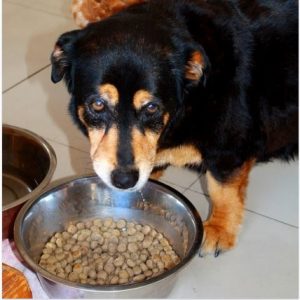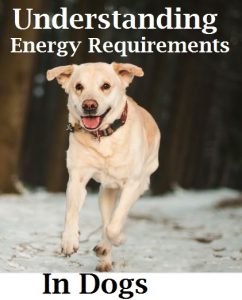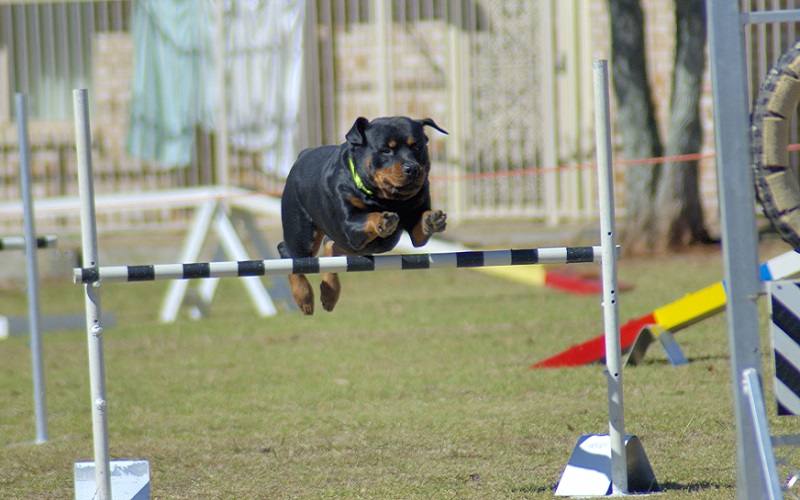Understanding your dog’s energy requirements is important because the main key function of eating food is to gain energy. All living creatures need energy to sustain all bodily functions. Energy requirements vary from one dog to another based on several factors. Knowledge about energy requirements in dogs is important because this is ultimately what dictates how much food you need to feed your dog. While pet food labels suggest how much food to feed based on weight, this can be overly inaccurate because they don’t keep into consideration several factors.
Where Does Energy Come From?
The main source of energy is the sun which ultimately enables plants to produce energy-containing nutrients which are then directly consumed by animals eating such plants or indirectly by animals consuming animals that have eaten such energy-containing nutrients from plants.
While energy is not a nutrient per se,’ fats, carbs and proteins found in foods are all energy-containing nutrients that once ingested and digested are absorbed so to generate energy. Just like a light bulb will shut down when no longer supplied with electricity, life cannot be sustained if energy is no longer supplied by food. The body would gradually shut down and death would occur.
Dogs should be fed enough food to meet their energy requirements. Energy requirements vary from dog to dog and the energy content of food also varies. While pet food labels suggest feeding dogs a certain quantity based on the dog’s weight, this is a only one piece of the puzzle. There are several other factors to keep into consideration.
 Measuring Energy Requirements
Measuring Energy Requirements
There are several ways a dog’s energy requirements can be calculated. Resting Energy Requirement (RER) refers to the amount of energy that a dog needs while remaining at rest in a thermoneutral environment (range of ambient temperatures where metabolic rate is minimal).
To obtain your dog’s Resting Energy Requirement (if your dog weighs between 5 and 99 pounds or between 2 and 45 kg ) you will have to use this formula: RER = dog’s weight in kilograms x 30, + 70.
To figure out your dog’s weight in kilograms you can use this pounds to kilograms calculator. The final RER number you obtain from the above calculation should range between 130 and 1,420. Let’s see a practical example.
So if your dog weights 87 pounds, that’s 39.462 kilograms. So you take 39.462 and multiply it by 30 which makes 1183.86. You then add 70 and the total comes to 1253.86. This number provides you with the number of calories your dog’s body burns at rest. If your dog lays around all day, this number can be close to accurate, but there may be several other factors to consider that can increase your dog’s energy requirements, and significantly too!
And what if your dog weighs less than 5 pounds or more than 99 pounds? Then, you will need to use the exponential formula which is RER = 70 [body wt in kg0.75].
 A Multitude of Factors
A Multitude of Factors
Unless old and sick, most dogs are not likely to be immobile the whole day, so it’s important to consider that any activity other than rest requires an increase in energy requirements which means a need for ingesting more calories. So an adult dog with normal activity levels can be already at 1.6 times the resting energy requirement. Following are several factors to keep into consideration.
The Impact of Growth
Puppies have increased energy needs during growth because they need all the energy then can get to form new tissue. Growth is at its peak from weaning (around 3-4 weeks) up to when the pup is four months old. During this time, the puppy’s energy requirements can be 3 times the resting energy requirement. Energy requirements then lower to 2 times the resting energy requirement from four months of age up to when the pup reaches adult size.
It’s important to keep in mind that too much of a good thing can harm a growing puppy! Excess energy intake in a growing puppy can lead to obesity and developmental orthopedic disease, especially in large and giant breed puppies.
The Impact of Reproduction
Reproduction takes some additional energy expense which results in higher energy requirements. When a female dog is pregnant, most rapid fetal development occurs in the last third trimester of pregnancy, which takes place after day 40 of gestation with the highest energy requirements peaking between weeks 6 and week 8 of pregnancy. During this time, energy requirements are 3 times the resting energy requirement for most dogs, but larger breeds may require more.
Production of milk is one of the most energy demanding times of all. Depending on the dog’s size and breed, during lactaction energy requirements can range from 4 times to as high as 8 times the dog’s resting energy requirement! With an abdomen full of puppies leaving little room for food in the digestive tract, pregnant dogs benefit from a light, easy-to-digest diet fed in several small meals during the day. A high quality puppy formulation is generally recommended during the third trimester of pregnancy so to ensure adequate calorie intake.
The Impact of Age
Older dogs tend to generally require fewer calories compared to young and adult dogs. This is mostly due to the fact that, as dogs age, they tend to move around less. According to studies, dogs over the age of seven showed a 10 to 20 percent less need for energy compared to younger dogs between the ages of three and seven. Senior dogs therefore benefit in a caloric reduction, but there are exceptions to the rule when it comes to senior dogs who engage in physical activity.
The Impact of Activity
On top of lactation, another factor that can significantly increase energy requirements is activity. Just think that the simple fact of standing up, requires 40 percent more energy than lying down! Generally, normal activity can raise the resting energy requirements anywhere between 1.6 to 1.8 times, with light work increasing up to 2 times and moderate work raising up to 3 times more. Prolonged heavy activity instead can raise the resting energy requirement anywhere from 4 to 8 times more, just as a dog producing milk!
The Impact of Climate
Even the climate where your dog lives can have an impact on energy requirements in dogs. Thermoregulation, the body’s work to maintain its internal core at an ideal temperature, takes energy. Consider that dogs who are left outdoors in the cold winter will need anywhere between 10 and 90 percent more calories than when a dog is exposed to an optimal temperature. This is because it takes energy expense to maintain core temperature to an optimal level.
Energy expense is also higher when a dog is in a warm climate, as it takes energy to dissipate heat, however, when dogs are maintained in a thermoneutral environment, which means the dog is exposed to ambient temperatures where metabolic rate is minimal, the energy loss is minimal.
The Impact of Breed
Even the breed of dog can have an impact of caloric needs. For example, Newfoundlands and Siberian huskies are known for having low energy requirements. On the other hand, great danes are known for having requirements that are higher than average.
The Impact of Health
There are certain medical conditions that require the body to repair itself and this can lead to increased energy expense. Dogs may need to recover from trauma, repair wounds or mount an immune response against diseases like cancer. Nutrients that supply energy are important so to sustain the body in these times of need. Something to consider though is that often ill dogs are inactive and this can lower their energy requirements. With this in mind, the energy requirements of sick dogs may often stay close to resting energy requirements.
 The Bottom Line
The Bottom Line
As seen, there are several factors that play a role in a dog’s energy requirements. Keeping these factors in mind is important.
However, calculating your dog’s caloric intake based on energy expense can be tricky. While pet food labels offer a rough guide on how much food to feed your dog based on weight, these guidelines ignore other factors.
For instance, you will have to factor in any treats or table scraps given throughout the day which can lower the amount of food to feed. For help in identifying your dog’s caloric requirements consult with your vet or a veterinary nutritionist.
References:
- Merck Veterinary Manual, Nutritional Requirements and Related Diseases of Small Animals
- VCA Animal Hospital, Feeding the Pregnant Dog
- Lewis, L; Morris, M; Hand, M. Small Animal Clinical Nutrition 3rd Edition. Mark Morris Associates. Topeka, KS; 1987.
- Pet Education, How Much to Feed A Dog to Meet His Energy Needs




 Measuring Energy Requirements
Measuring Energy Requirements A Multitude of Factors
A Multitude of Factors The Bottom Line
The Bottom Line